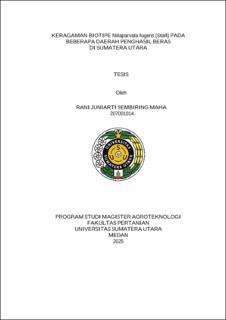| dc.description.abstract | The brown planthopper (Nilaparvata lugens) is a major rice pest that causes
significant crop losses throughout Asia. The purpose of this study was to
determine the biotype diversity of bWBC in four rice-producing districts in
North Sumatra: Asahan Regency, Batubara Regency, Deli Serdang Regency,
and Langkat Regency. The results of the morphology study of the WBC
imagos revealed a macropteran body length of 4,36 mm and a brachypteran
body length of 3,51 mm. The imago antennae consist of three parts: the scape,
pedicel, and flagellum. Four WBC samples were tested in the laboratory using
the Polymerase Chain Reaction (PCR) technique. Samples identified by PCR
using the universal insect mitochondrial primers LCO 1490/HCO 2198,
resulted in amplification of 700 bp. Sequencing was then performed for
phylogenetic analysis. The PCR test results were analyzed descriptively using
MEGA version 11. The sequence data from four Nilaparvata lugens samples
were aligned with four sequence data from GeneBank: MK301229.1
(Nilaparvata lugens biotype Y), JN563997.1 (Nilaparvata lugens biotype 3),
JN563996.1 (Nilaparvata lugens biotype 2), and JN563995.1 (Nilaparvata
lugens biotype 1). The genetic distance between the samples in this study was
0,000 indicating a very close relationship between the four samples. The
genetic distance between the four samples was 0,578 to Nilaparvata lugens
biotype 1 and 0,596 to Nilaparvata lugens biotypes 2, Nilaparvata lugens 3,
and Nilaparvata lugens biotype Y. This indicates a close kinship between the
four samples and the Nilaparvata lugens biotype in GeneBank. Gene mutations
or biotype changes in Nilaparvata lugens. Farmer characteristics revealed that
the majority of respondents were 41-50 years old, had a high school education,
and were mostly male. The majority of respondent farmers used the Inpari-32
variety, which is somewhat susceptible to WBC. The majority of respondent
farmers used synthetic pesticides to control WBC. Some farmers used more
than three types of pesticides. 96,67% of respondent farmers in Batubara
Regency controlled WBC by using synthetic pesticides more than three times
during a planting period. WBC infestations during a single planting period
varied from 1% to 5% of farmers' land area expansion. The statistical analysis
results showed a relationship between the variety used and the level of WBC
infestation, with a significance value (0.00). The main problem most frequently
experienced by farmers was pests and diseases, with more than 50% of farmers
interviewed citing this as the problem. | en_US |


